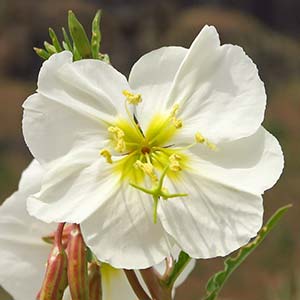Oenothera grandiflora
Oenothera pallida
large-flower evening-primrose
mountain evening primrose, pale evening-primrose, rockweed brush, white-stem evening primrose
erect, red on proximal parts, usually green on distal ones, rarely red throughout, unbranched or with branches obliquely arising from rosette and secondary branches arising from main stem, 100–300(–400) cm.
erect or ascending, single to several from base, unbranched or many-branched throughout, 10–50(–70) cm.
in a basal rosette and cauline, basal 18–32 × (2–)3–6.5 cm, cauline 6–20 × 1.5–6.5 cm;
blade soft and thin, bright green, usually flat, rarely undulate, narrowly oblanceolate to narrowly obovate, or narrowly elliptic to elliptic, sometimes narrowly ovate distally, margins bluntly dentate or subentire, teeth widely spaced, sometimes sinuate-dentate proximally or lobed;
bracts usually caducous.
cauline, rosette usually weakly developed or absent, at least during flowering, sometimes well developed, 1–5(–7.8) × 0.3–1(–1.5) cm;
petiole 0–2(–4.5) cm;
blade lanceolate, oblong, linear-lanceolate, or ovate, margins subentire or remotely denticulate, deeply sinuate-dentate, or pinnatifid, sometimes repand.
erect, often with secondary or tertiary branches just proximal to main one.
opening near sunset;
buds erect, 5–9 mm diam., with free tips terminal, erect, 2–9 mm;
floral tube 35–55 mm;
sepals yellowish green or flushed with red, 22–46 mm;
petals yellow to pale yellow, fading pale yellowish white, very broadly obcordate or obovate, (25–)30–45 mm;
filaments 18–27 mm, anthers 10–15 mm, pollen 90–100% fertile;
style 57–90 mm, stigma exserted beyond anthers at anthesis.
1–several opening per day near sunset;
buds nodding, weakly quadrangular, with free tips 0–2 mm;
floral tube 15–40 mm;
sepals 10–30 mm, not spotted;
petals white, fading pink to deep pink, broadly obovate or obcordate, (10–)15–25(–40) mm;
filaments 9–15 mm, anthers 3–10 mm;
style 25–55 mm, stigma exserted beyond anthers at anthesis.
erect or slightly spreading, dull green when dry, narrowly lanceoloid to narrowly ovoid, 15–35 × 3.5–5.5 mm, free tips of valves 0.5–2.5 mm.
spreading to reflexed, straight to curved or contorted, cylindrical, obtusely 4-angled, tapering slightly from base to apex, 15–60 × 1.5–2.5 mm;
sessile.
1–1.7 × 0.6–1.2 mm.
numerous, in 1 row per locule, brownish with dark spots or black, narrowly obovoid, 1.5–2.2 mm.
= 14.
Oenothera grandiflora
Oenothera pallida
Oenothera grandiflora has a scattered distribution, from the eastern half of Mississippi and Alabama, east to Tennessee (Franklin and Marion counties), North Carolina (Cherokee, Macon, Martin, Moore, New Hanover, Sampson, and Swain counties), South Carolina (Oconee, Spartanburg, and Sumter counties), and Florida (Alachua, Escambia, Franklin, Lake, Leon, Polk, Putnam, and Santa Rosa counties). Collections from southern Canada, New York, Pennsylvania, Vermont, and West Virginia almost certainly represent cultivated plants, garden escapes, or adventive populations, and the single locality from central Kentucky also may be an introduction; it is sometimes a colonizer in disturbed sites such as along roads.
Oenothera grandiflora has plastome III and a BB genome composition. As summarized by W. Dietrich et al. (1997), some populations of O. grandiflora seem to be entirely or mostly composed of self-incompatible individuals, whereas others consist of self-compatible plants. This is an extremely uncommon phenomenon within a single species of Oenothera; the only other species known to exhibit mixed populations of self-incompatible and self-compatible individuals is O. primiveris.
Oenothera grandiflora Lamarck 1798, being a later homonym of O. grandiflora L’Héritier 1789, pertains here.
(Discussion copyrighted by Flora of North America; reprinted with permission.)
Subspecies 4 (4 in the flora).
Oenothera pallida is a poorly understood species currently subdivided into four subspecies (W. L. Wagner et al. 2007) that differ largely in aspect, leaf division, capsule configuration, and pubescence. The variation pattern is rather complex with almost no diagnostic character uniformly distinguishing any one of the subspecies. Instead, each of the subspecies, which are mostly geographically separated although there is some level of overlap, have diagnostic suites of characters that maintain their linkage some of the time, but break down across the geographic area of each so that no single character uniquely identifies it. Each subspecies is characterized by leaf, pubescence, and, often, habit features. The issues with the integrity and intergradations of the subspecies are discussed below.
Oenothera pallida has been determined to be self-incompatible (W. L. Wagner et al. 2007), but K. E. Theiss et al. (2010) determined that although most populations of subsp. pallida are self-incompatible, one near Salt Lake City is self-compatible.
(Discussion copyrighted by Flora of North America; reprinted with permission.)
1. Herbs annual, sometimes perennial from a taproot, when perennial, sometimes with lateral roots producing adventitious shoots, strigillose throughout and villous distally, especially on flower parts. | subsp. trichocalyx |
1. Herbs perennial from a taproot and with lateral roots producing adventitious shoots, glabrous, strigillose, or sparsely villous. | → 2 |
2. Plants glabrous, sometimes strigillose, rarely sparsely villous; leaf blade margins usually subentire or remotely denticulate, rarely pinnatifid; capsules usually contorted to curved. | subsp. pallida |
2. Plants usually strigillose, rarely villous or glabrous; leaf blade margins shallowly sinuate-dentate or denticulate, or deeply sinuate-dentate to pinnatifid, rarely only dentate; capsules usually straight or curved, sometimes contorted. | → 3 |
3. Leaf blades (0.4–)0.7–1.5 cm wide, margins shallowly sinuate-dentate or denticulate. | subsp. latifolia |
3. Leaf blades 0.4–1(–1.5) cm wide, margins usually deeply sinuate-dentate to pinnatifid, rarely dentate only. | subsp. runcinata |
